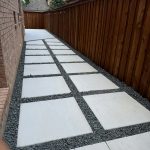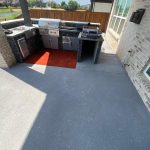Cracks in your concrete or gunite pool can be more than just an eyesore—they can lead to costly damage if left untreated. Whether you’ve spotted a hairline crack or a deep structural split, fixing it fast is key. In North Texas, where heat and shifting soil are common, concrete pool repair needs to be both durable and expertly done.
Here’s a practical guide to help you understand how to repair pool cracks—whether you’re considering a DIY patch or hiring a professional.
How to Identify Pool Cracks in Concrete and Gunite
Before you fix anything, you need to know what you’re dealing with. Common types of pool cracks include:
- Hairline cracks: Thin surface cracks in the plaster or finish. Usually cosmetic, but can grow.
- Structural cracks: Deeper splits in the gunite or concrete shell, often caused by shifting soil or poor installation.
- Spider cracks: Web-like patterns on the pool surface. Often found in older plaster finishes.
- Horizontal cracks: Typically found along steps or around the pool walls—signs of movement.
If your pool is losing water or has visible cracks, don’t wait. According to Marcos, owner of Professional Brick & Stone Works:
“A small crack in your pool today can become a major structural issue tomorrow—especially with Texas weather extremes.”
Best Methods for Pool Concrete Repair
The method you choose depends on the size and type of crack.
1. Hairline Crack Repair
Hairline cracks are usually cosmetic but should be sealed to prevent water intrusion.
DIY Option:
- Use a concrete pool crack patch or pool crack filler.
- Clean the area thoroughly.
- Apply with a trowel or putty knife.
- Let it cure completely.
When to Call a Pro:
If cracks reappear or spread, it may be a sign of deeper issues.
2. Gunite Pool Crack Repair
Gunite pools are strong, but they’re not crack-proof. Patching gunite takes experience.
Professional Method:
- Drain pool if needed.
- Widen the crack into a “V” shape for better adhesion.
- Apply a gunite pool patch product (usually hydraulic cement or epoxy-based filler).
- For larger damage, apply mesh and multiple layers of repair compound.
Marcos adds:
“Gunite repair isn’t just about filling gaps—it’s about understanding the structure beneath. That’s where our 15+ years of experience makes a difference.”
3. Structural Pool Crack Repair
This is the most serious type and should never be handled without expert input.
Professional Solution:
- Full inspection and possibly dye testing to track water leaks.
- Rebar may be exposed and cleaned or replaced.
- High-strength bonding agents and structural epoxy injection are applied.
- Often includes resurfacing or replastering the entire pool area.
Tools and Materials Used in Pool Crack Repair
Whether DIY or professional, quality tools and materials matter. Some essentials include:
- Crack chasers or angle grinders
- Waterproof epoxy or hydraulic cement
- Pool-safe patch kits
- Bonding agents
- Caulking guns (for flexible sealants)
- Waterproof mesh (for deeper repairs)
For large repairs, contractors may use industrial-grade products not sold in big box stores.
Should You DIY or Hire a Pro?
DIY Repair May Be Right If:
- Crack is small and surface-level.
- You’re experienced with basic masonry or concrete work.
- You’re using a fix pool cracks DIY kit for cosmetic touch-ups.
Hire a Pool Repair Expert If:
- Cracks are spreading or near drains, steps, or structural joints.
- You suspect water loss or soil movement.
- You want a warranty-backed, professional finish.
Remember, North Texas soil shifts with every weather cycle. It’s not just about fixing the crack—it’s about preventing the next one.
Tips for Preventing Future Pool Cracks
- Install a proper drainage system around your pool.
- Seal the surface every few years.
- Avoid draining your pool during hot weather (can cause structural stress).
- Maintain water chemistry to avoid surface degradation.
When to Resurface Instead of Repair
If your pool has multiple cracks, surface stains, or rough texture, it may be time for pool resurfacing. This involves stripping down the finish and applying new plaster, quartz, or pebble coating. It’s more expensive than a patch—but lasts 10–15 years when done right.
Final Thoughts: Don’t Let Cracks Ruin Your Pool Investment
Cracks in your concrete or gunite pool aren’t just a cosmetic problem—they can compromise your pool’s structure and lead to expensive leaks. Whether you need a simple hairline crack filler or full swimming pool structural crack repair, the best fix starts with an expert eye.
Marcos of Professional Brick & Stone Works says:
“We’ve repaired everything from minor spider cracks to major gunite blowouts. Our goal is always the same—protect your pool, your property, and your peace of mind.”
Need pool concrete repair in Collin County, McKinney, Murphy, or Wylie?
Call Professional Brick & Stone Works today for a free quote and expert consultation. Whether it’s a simple patch or full structural fix, we’ll get your pool back in shape—built to last through Texas heat and soil shifts.
More Information:
https://www.tdhca.state.tx.us/single-family/training/docs/14-TMCS.pdf








